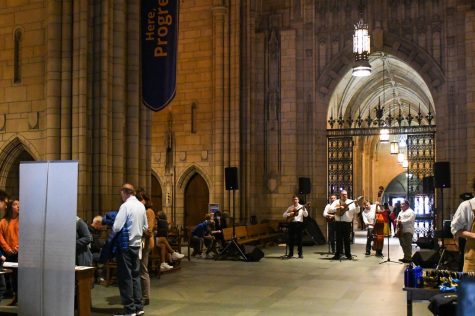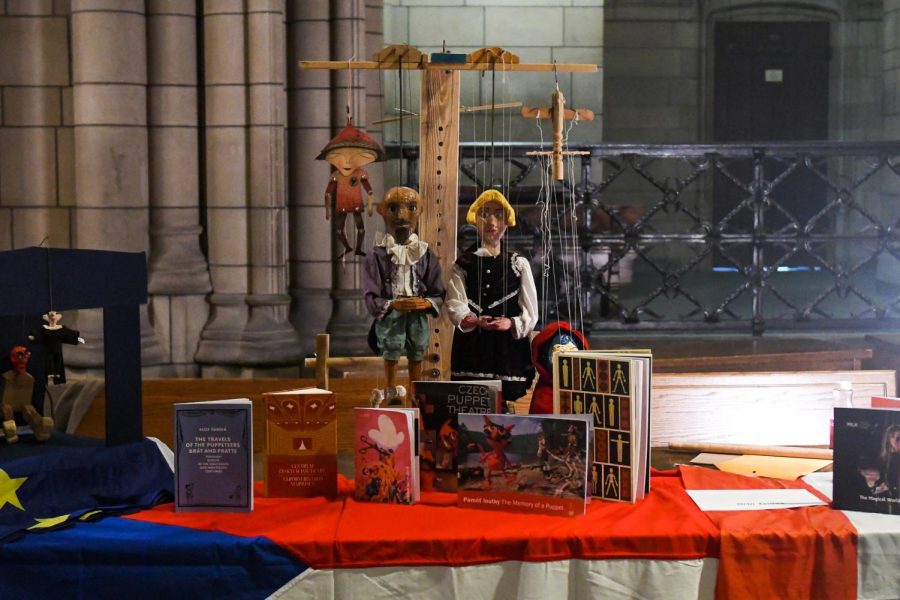East European Festival celebrates cultural diversity with fashion, music and more
A culture table at the East European Festival in the Cathedral of Learning on Sunday.
October 16, 2022
Music, food, and lots of cultural pride dominated the East European Festival on Sunday in the Cathedral of Learning.
Pitt’s Center for Russian, East European and Eurasian Studies held the festival, which featured vendors, educators, and advocates with roots from nearly every country in Eastern Europe. Roughly 100 people attended the event.
Vendors displayed some traditional Eastern European fashion, and each finely detailed dress and shirt expressed something about the country that it was from. One example is a cream-colored Romanian shirt with small black speckles on the collar that appeared simple from afar but had lots of detail up close.
Live music also entertained the attendants during the festival. Gipsy Stringz, an acoustic quartet that plays Eastern European music with traditional instruments, was the first act. Later in the day, singers Kathleen Manukyan and Zuly Inirio treated the crowd with some songs while Robert Frankenberry played the piano.
Children sat doing arts and crafts. Some crafted paper snowflakes, a tradition in Poland, while others excitedly colored outlines of various Eastern European countries.

(Pamela Smith | Visual Editor )
Larry Kozlowski, a folk artist who was manning the paper snowflake station, recounted the importance of passing down traditions. He said people should be familiar with their own heritage, especially when they age and find themselves lonely.
“It teaches us who we are, where we came from, and where we are going,” Kozlowski said.
“Once your parents die… It’s the only connection you have to the past, which opens up the future.”
He said people need to learn about culture outside of the classroom, which many Americans struggle with because they have lost touch with their family’s culture over time. He added that people can get in touch with different cultures to broaden their worldview.
“We are all one but many… anyone has as much culture as anybody else,” Kozlowski said.
Areti Papanastasiou, a modern Greek professor, said coming into contact with cultures other than your own enables a clearer understanding of your own culture. She pointed out that many English words have Greek origins, including words like philosophy, chaos and mathematics.
“Once you get another culture, you will understand the nuances of your own,” Papanastasiou said. “About 25% of words in English have Greek roots.”
Vendors also shared their culture with attendees by selling various items from their home countries. Lesya Jurgovsky stood behind a table with a variety of cultural Ukrainian clothing for sale. Jurgovsky runs a charity to help people in Ukraine who are suffering as a result of the Russian invasion earlier this year.
“I run a Ukrainian charity for victims of war 一 orphans and other people who have been displaced and cannot leave Ukraine,” Jurgovsky said. “This is why I’m here today 一 to support Ukrainian people.”
Despite their varying backgrounds, each individual present had a deep appreciation for their own culture and for the intermingling of cultures. Whether they came to pass down old traditions, share their love of a language, raise money for charity or share ethnic cuisine, they all did it out of this appreciation.
“We’re all different, but we’re all similar in laughing, crying and everything in between,” Kozlowski said. “A family is not what it used to be, but love has no language. It is a language of your heart that you speak.”








